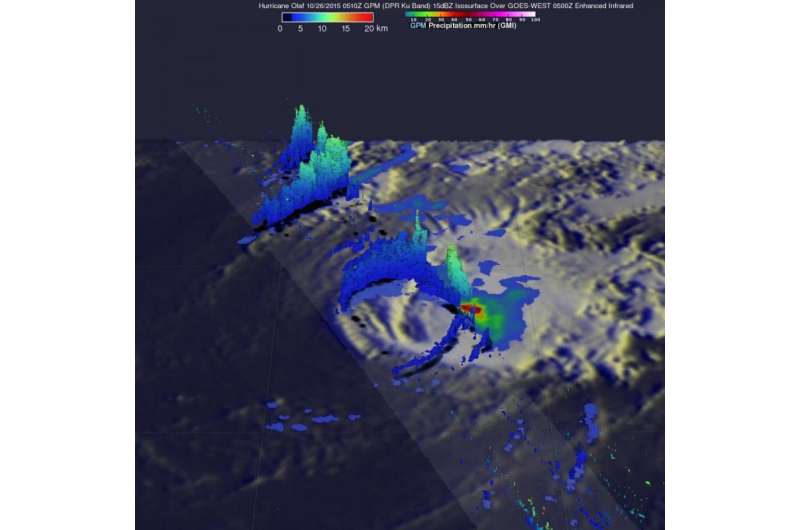Weakening post-Tropical Storm Olaf examined by NASA's GPM satellite

After maintaining hurricane intensity for over a week former category four hurricane Olaf is now a post-tropical storm and moved into hurricane history. The GPM core observatory satellite flew above Olaf and analyzed the rainfall within the storm.
The Global Precipitation Measurement mission or GPM core satellite is managed by both NASA and the Japan Aerospace Exploration Agency. It flew over Olaf on October 26, 2015 at 0510 UTC (1:10 a.m. EDT).
Rainfall data was derived from GPM's Microwave Imager (GMI) and Dual-Frequency Precipitation Radar (DPR) instruments. Olaf had moved over cooler waters that were sapping the tropical cyclone's energy. GPM's GMI found that storms located in a small area within Olaf were still dropping rain at a rate of over 65 mm (2.6 inches) per hour.
GPM's radar (DPR Ku band) sliced through Olaf's western side and revealed that rainfall was sparse in that area. In a 3-D image created at NASA's Goddard Space Flight Center in Greenbelt, Maryland, the precipitation structure on the storm's western side showed that the highest storm tops were reaching heights of 12 km (7.4 miles). Rain in these storms was measured by DPR falling at a rate of up to 62 mm (2.4 inches) per hour.
By October 27, Olaf had crossed the 140 degree latitude line and moved from the Central Pacific Ocean into the Eastern Pacific Ocean where it become post-tropical.
On Tuesday, October 27, 2015 at 11 a.m. EDT (1500 UTC), the center of Post-Tropical Cyclone Olaf was located near latitude 26.7 degrees north and longitude 135.1 degrees west. It was about 1,355 miles (2,180 km) east-northeast of Hilo, Hawaii. The post-tropical cyclone was moving toward the east-northeast near 10 mph (17 kph), and the low pressure area is expected to turn toward the southwest and west-southwest on Wednesday, October 28. Maximum sustained winds were near 45 mph (75 kph) with higher gusts. The estimated minimum central pressure was 1000 millibars.
The National Hurricane Center forecast weakening over the next two days and issued its final bulletin on the storm. The post-tropical cyclone is expected to dissipate by Thursday, October 27, 2015.
Provided by NASA's Goddard Space Flight Center
















